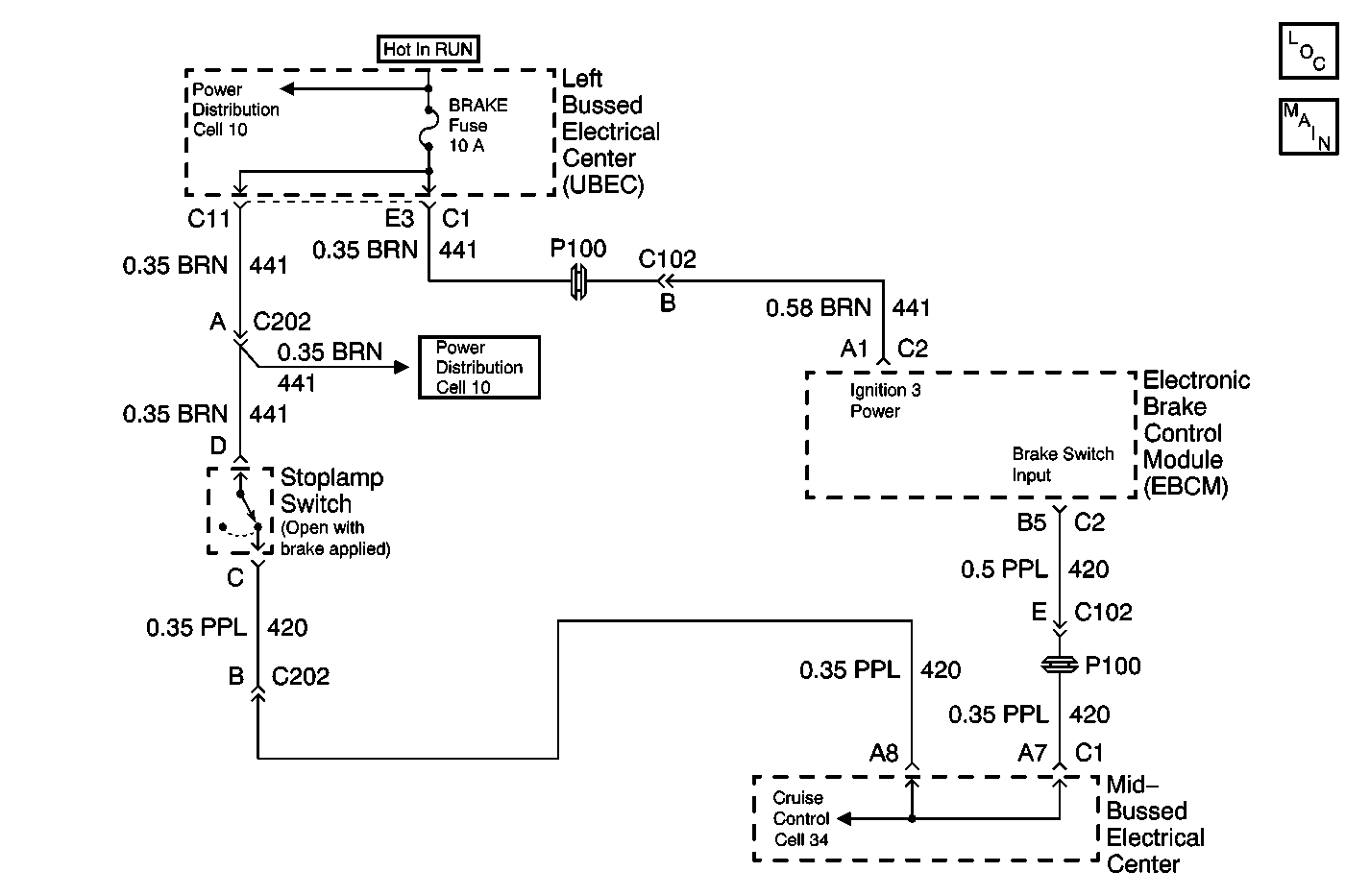
Circuit Description
The stoplamp switch is normally closed when the brake pedal is released. With the ignition in the RUN position and the brake pedal released, ignition voltage is supplied to terminal B5 of the EBCM. When the brakes are applied, the voltage will drop to zero at terminal B5. The EBCM monitors the status of the brake switch. If the brake switch signal is detected at the wrong time, or if it is not detected when the EBCM expects it, DTC C0281 will set.
Conditions for Setting the DTC
| • | After power up, the EBCM never detects that the brake switch has been released before the vehicle reaches 56 km/h (35 mph). |
| • | The vehicle is in an ABS stop involving all three hydraulic channels for more than 1 second without the EBCM detecting that the brake switch has been applied. |
Action Taken When the DTC Sets
| • | The ABS is not disabled. |
| • | The ABS indicator lamp will not light. |
DTC C0281 is an Information Only DTC. The DTC is stored in memory, but the ABS indicator lamp will not light and ABS will not be disabled.
Conditions for Clearing the DTC
| • | Repair the conditions responsible for setting the DTC |
| • | Use the Scan Tool Clear DTCs function |
Diagnostic Aids
DTC C0281 can be set by a faulty stop lamp switch, or damage in CKT 420 or 441.
Thoroughly check any circuitry that is suspected of causing the intermittent complaint for the following conditions:
| • | Backed out terminals |
| • | Improper mating |
| • | Broken locks |
| • | Improperly formed or damaged terminals |
| • | Poor terminal to wiring connections |
| • | Physical damage to the wiring harness |
Test Description
The numbers below refer to the steps in the diagnostic table:
-
Use the scan tool data list display to monitor the brake switch status.
-
This step will try to simulate an open stoplamp switch by removing the stoplamp switch harness connector.
-
This step decides between a short to voltage in CKT 420 and a malfunctioning EBCM.
-
This step eliminates an open in CKT 420 as a possible cause.
-
Damage or corrosion to the EBCM 16-way harness connector terminals could be the cause for an intermittent DTC to set.
Step | Action | Value(s) | Yes | No | ||||
|---|---|---|---|---|---|---|---|---|
1 | Was the Diagnostic System Check performed? | -- | Go to Step 2 | |||||
Does the scan tool show the Brake Switch Status changing from ON (brake applied) to OFF (brake released? | -- | Go to Step 7 | Go to Step 3 | |||||
3 | Does the scan tool indicate that the Brake Switch Status is OFF constantly? | -- | Go to Step 4 | Go to Step 6 | ||||
Does the scan tool show the Brake Switch Status changing from OFF (brake released) to ON (brake applied? | -- | Go to Step 11 | Go to Step 5 | |||||
Is the voltage within the specified range? | 5-15V | Go to Step 12 | Go to Step 14 | |||||
Is the resistance within the specified range? | 0-2ohms | Go to Step 15 | Go to Step 13 | |||||
Is there damage to the stoplamp switch or wiring harness? | -- | Go to Step 9 | Go to Step 8 | |||||
8 | Reconnect the stoplamp switch connector and observe the Brake Switch Status on the scan tool while applying and releasing the brake pedal. Does the scan tool show the Brake Switch Status changing from ON (brake applied) to OFF (brake released? | -- | Go to Step 10 | Go to Step 14 | ||||
9 | Repair or replace damaged or corroded terminals, or damaged harness. Is the repair complete? | -- | -- | |||||
10 | Malfunction is intermittent.
Is the repair compete? | -- | -- | |||||
11 | Replace the stoplamp switch. Refer to Stop Lamp Switch Replacement . Is the repair complete? | -- | -- | |||||
12 | Repair the short to voltage in CKT 420. Is the repair complete? | -- | -- | |||||
13 | Repair the open or high resistance in CKT 420. Is the repair complete? | -- | -- | |||||
14 | Replace the EBCM. Refer to Electronic Brake Control Module Replacement . Is the repair complete? | -- | -- | |||||
15 |
Is the voltage within the specified range? | 10-15V | Go to Step 11 | Go to Step 16 | ||||
16 | Repair the open in CKT 441. Is the repair complete? | -- | -- |
